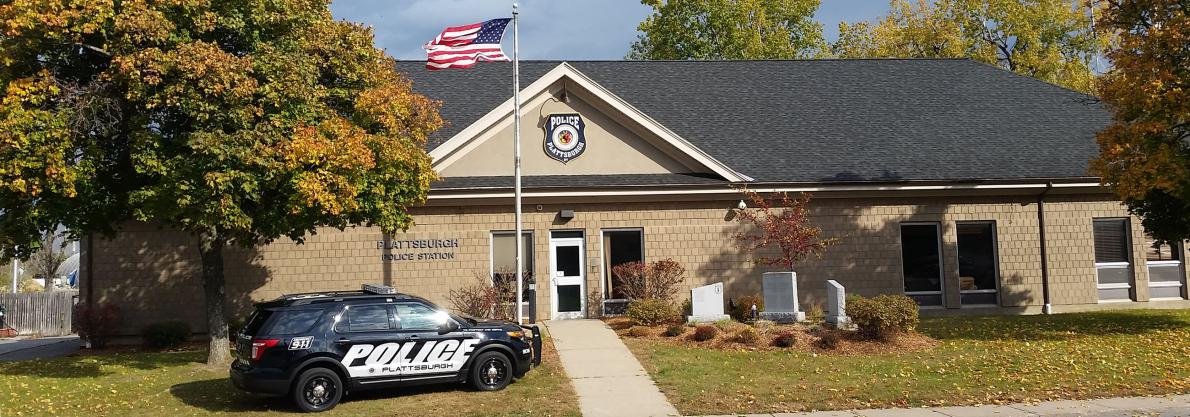The Plattsburgh City Police Department (PCPD) serves the City of Plattsburgh, New York, a border‐adjacent community on Lake Champlain with a large state university and regional transportation corridors. The department’s headquarters is located at 45 Pine Street, Plattsburgh, NY 12901; the main non-emergency line is 518-563-3411, and 911 is used for emergencies.
In May 2025, the City Common Council confirmed Jarrod Trombley as Chief of Police, succeeding prior leadership and marking a new administrative chapter for the agency. This leadership change coincided with continuing implementation of New York’s Executive Order 203 police-reform initiatives adopted locally in March 2021.
Budget planning documents for FY 2025 indicated staffing growth with the addition of four police officers to maintain “strong staffing levels,” reflecting the city’s commitment to patrol coverage and investigative capacity.
Table of Contents
Jurisdiction, Mission, and Community Setting
Plattsburgh’s geography—minutes from the Canadian border, with interstate, rail, and lake access—drives a policing mission that mixes neighborhood service with regional readiness. The city emphasizes a generally high quality of life alongside unique operational demands tied to border proximity, a large SUNY campus, and regional correctional facilities. These elements influence training, patrol design, and interagency coordination.
The department’s mission centers on public safety, crime prevention, and responsive service to residents, businesses, students, and visitors. PCPD highlights technology integration (e.g., statewide criminal and traffic databases and LiveScan fingerprinting) to improve investigative efficiency and identity verification during arrests and civil processes.
Organizational Structure and Functions
The PCPD is organized into functional divisions that collectively manage front-line response, follow-up investigations, youth engagement, parking enforcement, and department administration. The main cores are Patrol, Detective, Juvenile, Parking Violations, and Administrative divisions.
Detective work is guided by city code provisions describing responsibilities such as criminal investigations, witness and suspect interviews, evidence handling, court preparation, and prisoner transport. Supervisory roles (e.g., a Detective Lieutenant) include oversight of major investigations, property recovery, and case management. These codified duties shape investigative standards and accountability.
Facilities, Contact, and Public Access
PCPD operations are based at 45 Pine Street with 911 for emergencies and 518-563-3411 for non-emergency service and general inquiries. Forms and applications (e.g., records requests and other administrative processes) are available through the city’s police pages. Office contact details are consistently provided across city channels for ease of public use.
Staffing, Budget Signals, and Reform Implementation
City budget materials for 2025 noted an increase of four officers, indicating an emphasis on maintaining coverage and response times. Earlier cycles (e.g., 2021–2022) show typical municipal adjustments and prioritization across departments; however, the 2025 narrative specifically flagged police staffing as a focus area.
In parallel, Plattsburgh’s Police Reform and Reinvention process—mandated statewide by Executive Order 203—was developed with public input and adopted on March 31, 2021. Recommendations included expanding body-worn cameras and creating Crisis Intervention capacity to improve responses to behavioral-health incidents. Oversight and follow-through were assigned to a standing committee to track progress.
Snapshot Table — Agency Facts (2025)
| Item | Detail |
|---|---|
| Headquarters | 45 Pine Street, Plattsburgh, NY 12901 |
| Emergency / Non-Emergency | 911 / 518-563-3411 |
| Chief of Police | Jarrod Trombley (confirmed May 15, 2025) |
| Primary Divisions | Patrol; Detectives; Juvenile; Parking Violations; Administrative |
| 2025 Staffing Note | +4 sworn positions planned in FY 2025 budget narrative |
| Reform Plan Adoption | March 31, 2021 (Executive Order 203 compliance) |
| Technology | LiveScan fingerprinting; access to state traffic/criminal databases |
Training, Standards, and Accreditation Context
The city’s Police Academy training follows New York State Division of Criminal Justice Services (DCJS) mandates and lists over 639 hours of recruit instruction, with subject-matter experts drawn from multiple departments. This foundational training is designed to meet statewide standards for use of force, legal updates, defensive tactics, investigations, and scenario-based practice.
New York’s Law Enforcement Agency Accreditation Program is a voluntary standards framework covering administrative, training, and operational practices. Agencies seek initial accreditation and periodic re-accreditation on a five-year cycle. Local reporting in July 2025 stated that PCPD was not accredited at that time; accreditation status can change as agencies implement reforms and undergo assessments.
Services and Public Programs
PCPD provides routine patrol, traffic enforcement, collision investigation, and calls-for-service response, supported by detection and juvenile functions for case follow-up and youth-related matters. The department also manages administrative services for records and permits, along with public-facing programs coordinated through departmental contacts.
Community-engagement efforts have been tied to the reform plan, with structured feedback periods, public meetings, and ongoing dialogue through the oversight committee. The city documented open comment windows and council action milestones leading up to adoption of the local plan in 2021.
Governance and Labor
As a city department, PCPD operates under municipal code provisions that define roles (e.g., detective ranks), investigative responsibilities, and courtroom support. Labor relations and collective bargaining information for police units are maintained in statewide transparency portals that archive contracts for public reference, providing context about compensation structures and work rules.
Additional Context and Notes
University and county interfaces: Plattsburgh’s environment involves coordination with SUNY Plattsburgh public safety and neighboring law-enforcement agencies, particularly for events, student-related concerns, and regional operations.
Evolving policies: As with many New York agencies, technology (e.g., body cameras) and behavioral-health response models continue to evolve as budgets, staffing, and training adapt to community expectations and state guidance.
Useful List — When to Contact PCPD
- Emergencies: Dial 911 (imminent threats to life, serious crimes in progress, major accidents).
- Non-emergencies: Call 518-563-3411 (after-the-fact reports, minor collisions, welfare checks, noise complaints, non-urgent information).
- Administrative needs: Use city forms and department contacts for records requests, permits, or scheduled services.

